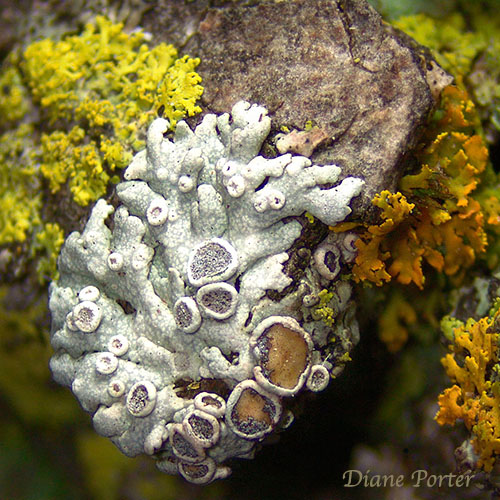Hoary Rosette Lichen
Could I eat it?

This white lichen looks to me like pasty dough, rolled out and lightly dusted with sugar. It is one of the "rosette" lichens, with the habit of spreading out in from a central point, like a rose blossom.
It's commly called Hoary Rosette Lichen or Gray Rosette Lichen. I like "Hoary" better, because it suggests the attractive whitish appearance. It sounds less drab than what "Gray."
This is the lichen I find most often in my woods. It covers almost every fallen twig and abounds on tree trunks. Often it is intimately mingled with other lichens. I think it makes pretty scenes.
Food for lichens
Every lichen is a combination character. The main structure of its body is a fungus. Like other fungi, it has no chlorophyl and is incapable of photosynthesis. It must depend on plants with DNA to create its sugar and energy.
Lucky for the lichen, inside of its fungal body lives a completely different organism, with its own separate DNA, which can photosynthsize. In the case of lichens in the genus Physcia, that other entity is a kind of algae. The two separate species of fungi and algae entwine and live together like a couple of teenagers in love. They cannot bear to let each other out of their sight, or they would simply die.
See the algae

If you take a razor blade and slice through the leaflike lichen, you can actually see the algae inside the body of the fungus. It's a thin green layer, just under the surface. It is called the photobiont, which means the part that lives by photosythesize sunlight.
Without its photobiont, the fungus could not live. And the algae needs the fungus, too. Algae are aquatic organisms, which need to be in water. The fungus provides a damp home and protection from drying out. It is a cozy, cooperative community they have going.
Lichen eats its greens
When the lichen gets wet, the surface becomes somewhat transparent. That allows sunlight to penetrate to the layer where the algae live, which lets the algae start photosynthesizing like mad. Suddenly you'll see the lichen turn green, because now you're seeing the green algal layer right through the surface of the lichen.
Field mark for Physcia
Lichenologists call this lichen Physcia aipolia. One of the ways to recognize lichens in the Physcia genus is by the little whitish specks in the surface.
 Those specks are tiny gaps in the algal layer.
They're particularly conspicuous when the lichen is damp and has turned green,
because of the transparency of the surface.
Those specks are tiny gaps in the algal layer.
They're particularly conspicuous when the lichen is damp and has turned green,
because of the transparency of the surface.
The pale spots are called "maculae" (which means "spots" in Latin). If you notice maculae on a lichen, that is a good clue that you're looking at a lichen in the genus Physcia.
Let me know
If someone has differing opinions on this lichen's identity, or more insight into the life history of the species, I'd love to hear from you. You can email me here.
— Diane Porter, Fairfield, Iowa, February 20, 2022

